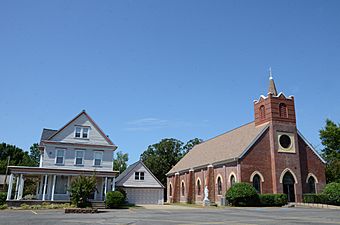Sacred Heart Catholic Church and Rectory (Wilburton, Oklahoma) facts for kids
Quick facts for kids |
|
|
Sacred Heart Catholic Church and Rectory
|
|
 |
|
| Location | 102 Center Point Rd., Wilburton, Oklahoma |
|---|---|
| Area | 1 acre (0.40 ha) |
| Built | 1912 |
| Architectural style | Gothic Revival |
| MPS | Latimer County Coal Mining TR |
| NRHP reference No. | 80003272 |
| Added to NRHP | November 6, 1980 |
The Sacred Heart Catholic Church and Rectory is a very old and important church building located at 102 Center Point Road in Wilburton, Oklahoma. This special place was built in 1912 and has been used continuously ever since. The church and its rectory (which is like a house for the priest) sit on a one-acre piece of land.
This site was added to the National Register of Historic Places (NRHP) on November 26, 1980. This means it's recognized as a significant historical place in the United States. When it was first built, it served about 150 coal miners and their families. Today, since the coal mining boom ended many years ago, the church usually serves between 75 and 80 people.
Contents
Sacred Heart Church: A Historic Place
The Sacred Heart Catholic Church is a beautiful example of a style called simplified Gothic Revival. This means it looks a bit like the grand churches built a long time ago in Europe, but with simpler details. The church building is about 48 feet (15 m) wide and 90 feet (27 m) long.
What Does the Church Look Like?
The church has a small steeple on top, which is a tall, pointed tower. Inside, you'll find nine stained-glass windows along the north and south walls. There are also two more stained-glass windows in the front wall. These windows are made of colorful pieces of glass that create beautiful pictures when sunlight shines through them.
The Rectory Building
Next to the church is the rectory. This is a three-story wooden building. It has a porch that wraps around the north and east sides. The inside of the rectory still looks much like it did when it was first built. It has its original wooden floors and special woodwork. The third floor of the rectory was once used as a home for children who had lost their parents, especially those whose parents were miners.
Bouncing Back from Damage
The church and rectory have faced some challenges over the years. In the 1930s, a fire damaged the church's roof and steeple. But don't worry, they were fixed! Later, in 1975, a tornado caused more damage to the roof and steeple of the church. The same storm also damaged the outside of the rectory. Each time, the buildings were carefully repaired and brought back to their original condition.
How It All Began
The land where the church and rectory stand was a gift from two men named James Degnan and James McConnell. They owned a company called the Eastern Coal and Mining Company. Many of their employees, who were coal miners, helped build the church and rectory. They worked on the buildings in their free time, after finishing their long shifts digging coal.
Degnan and McConnell also helped bring Father Glynn to Wilburton. Father Glynn was a missionary from New York and became the first pastor of the church. He also ran a school for students from first grade all the way to twelfth grade. This school operated until the late 1920s. The teachers at the school were Sisters of Mercy, who are members of a religious order.



